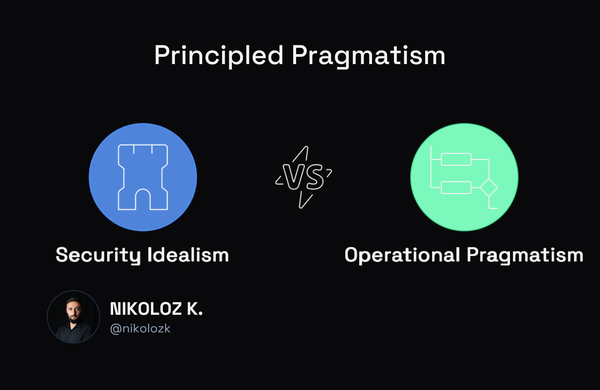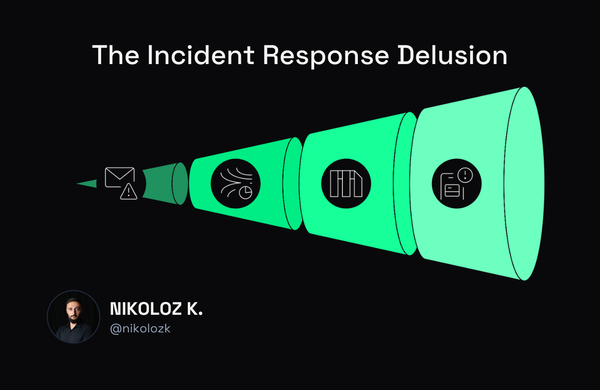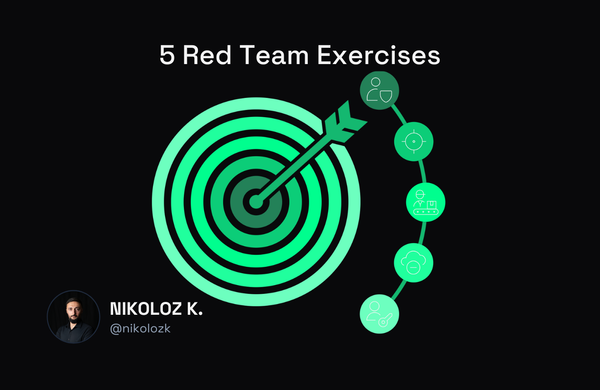Mastering SOC Maturity Levels: Your Ultimate Guide

Nikoloz Kokhreidze
Explore the 5 levels of SOC maturity, learn how to elevate your security operations center. From basic defenses to predictive analytics, budgets to headcount.

As the frequency and severity of cyber attacks continue to increase, businesses must prioritize building and maintaining effective security operations centers (SOCs). However, not all SOCs are created equal. In this post, we will discuss the five levels of SOC maturity, from the most basic to the most advanced. I will also provide a step-by-step guide on how to move from one level to the next, including budgeting and hiring indications.

Maturity Levels
It's important to note that the exact numbers for SOC maturity levels can vary significantly depending on factors such as region, industry, team maturity, company size, and other variables. Additionally, the financial indicators provided do not account for human resources. Thus, while this post offers approximate numbers for the number of security engineers and analysts needed for each type of organization and an estimated budget required for each level of SOC maturity, it's important to remember that these are not universal and may vary in practice.
Level 1: Basics/Defending the Perimeter
At Level 1, the priority is to lay the groundwork for a comprehensive security program. The focus is on identifying the boundaries of the security perimeter and taking steps to protect the organization's systems and data within that perimeter. Basic security measures, such as firewalls, antivirus software, and patching programs, are implemented to ensure the organization is equipped with adequate defense mechanisms against potential cyber threats.
The objective at this level is to establish a strong security foundation that can minimize the risk of unauthorized access, data theft, and other security breaches. This is accomplished through a combination of technical controls and security policies and procedures that are implemented across the organization. At Level 1, security alerts are typically managed manually, with security analysts reviewing and triaging alerts as they come in. The goal is to identify and remediate any potential security issues before they can cause damage to the organization's systems or compromise sensitive data. This requires a skilled and experienced security team that can quickly respond to potential threats and take the necessary actions to prevent or mitigate them.
Approximate FTE and Budgeting:
- Small Enterprises: 1-2 security engineers or analysts, $50,000-$100,000 budget
- Medium Enterprises: 2-4 security engineers or analysts, $100,000-$250,000 budget
- Large Enterprises: 4-6 security engineers or analysts, $250,000-$500,000 budget
Level 2: Visibility/SIEM and Data Lake
At Level 2, the focus is on building upon the foundational security program established in Level 1. The goal is to gain more visibility into the organization's security posture and to detect and respond to security incidents more efficiently. Organizations implement a Security Information and Event Management (SIEM) system or a Data Lake to achieve this goal. A SIEM system is a centralized platform that collects and aggregates logs from all security tools, providing a centralized view of security events across the organization. A Data Lake is a centralized repository that stores data from multiple sources in its raw form, providing a more comprehensive view of the data.
At this level, SecOps teams work on use case engineering, defining alerting and incident response playbooks. They establish rules and procedures that help identify suspicious activity and respond to incidents in a timely manner. The focus is on gaining visibility into the most critical alerts and contextualizing actual incidents. With the help of the SIEM or Data Lake, SecOps teams can correlate events across different security tools and identify patterns that may indicate a potential security incident.
Human analysts and engineers are crucial at this level. They are responsible for monitoring and investigating alerts generated by the SIEM and designing and implementing detection mechanisms. Analysts work on prioritizing alerts and investigating incidents to determine their severity and potential impact on the organization. This level also requires a more mature incident response capability, with well-defined incident response playbooks that outline the steps to be taken during a security incident.
Approximate FTE and Budgeting:
- Small Enterprises: 2-4 security engineers or analysts, $100,000-$250,000 budget
- Medium Enterprises: 4-6 security engineers or analysts, $250,000-$500,000 budget
- Large Enterprises: 6-8 security engineers or analysts, $500,000-$1,000,000 budget
Level 3: Automation/SOAR Implementation
Level 3 of the security maturity model is all about security automation. The primary objective of this level is to implement Security Orchestration, Automation, and Response (SOAR) to automate incident handling, streamline security operations, and integrate security tools. SOAR platforms combine security technologies and processes into a single framework to automate incident response, investigation, and remediation.
At Level 3, security teams start by creating automated playbooks for different attack types. They define the steps required to investigate, triage, and remediate each type of incident. These playbooks are then integrated with SOAR platforms, which can trigger the appropriate playbook automatically when a related incident is detected.
Teams also automate the response of Endpoint Detection and Response (EDR) systems at this level. When an incident occurs, the EDR system can automatically isolate the affected endpoint or take other pre-defined actions to contain the threat. This automation saves time by reducing manual intervention and allowing teams to focus on more critical tasks.
However, automation can make mistakes, and human oversight is still crucial at this level. Security teams need to review the automated playbooks and adjust them as needed regularly. They should also monitor the automation system's performance to ensure it works correctly and identify any issues requiring attention.
Approximate FTE and Budgeting:
- Small Enterprises: 4-6 security engineers or analysts, $250,000-$500,000 budget
- Medium Enterprises: 6-8 security engineers or analysts, $500,000-$1,000,000 budget
- Large Enterprises: 8-10 security engineers or analysts, $1,000,000-$2,000,000 budget
Level 4: Confidence/Advanced Analytics
Level 4 is the stage where SecOps teams gain confidence in detecting and responding to security threats effectively. This is achieved by implementing advanced analytics techniques that enable them to identify and mitigate potential security incidents with greater accuracy and speed.
To achieve this level of security maturity, SecOps teams need access to vast amounts of data, which they have consolidated into a data lake. This data lake contains log data from various security tools, such as SIEM systems, endpoint detection and response (EDR) tools, and other security products. With this data lake, SecOps teams can apply advanced analytics techniques to detect potential security incidents that may have gone unnoticed in earlier stages.
At Level 4, SecOps teams work on advanced incident response and forensic mechanisms, including irregular event analysis and anomalous machine activities. Threat intelligence-based searches come into play, which helps teams detect threats faster and more accurately by leveraging external threat intelligence feeds.
In addition, SecOps teams implement machine learning (ML) based analytics, which helps automate threat detection and response. These ML-based analytics are designed to identify patterns and anomalies in data that may indicate a security threat. This helps reduce the time and effort required for manual threat detection and response, enabling SecOps teams to focus on more complex tasks.
Approximate FTE and Budgeting:
- Small Enterprises: 6-8 security engineers or analysts, $500,000-$1,000,000 budget
- Medium Enterprises: 8-10 security engineers or analysts, $1,000,000-$2,000,000 budget
- Large Enterprises: 10-12 security engineers or analysts, $2,000,000-$5,000,000 budget
Level 5: Invisibility/Predictive Analytics
Level 5 is the highest level of SOC maturity, where teams can predict and respond to attacks with high confidence and accuracy. The focus is on using advanced predictive analytics techniques like machine learning and artificial intelligence to identify attack patterns and predict potential threats. By analyzing large volumes of data from multiple sources, including network logs, user behavior, and threat intelligence feeds, SOC teams can deeply understand their environment and identify patterns that may indicate an attack.
At this stage, SOC teams can conduct adversary simulations and identify likely attack paths, which helps them prepare for potential attacks and develop proactive security measures. These simulations help teams identify weaknesses in their security posture and develop more effective defenses. Additionally, adversarial deception can be utilized against active threats to feed attachers false information to gain deep insights into their behavior, Tactics, Techniques, and Procedures.
Behavior analytics and user activity anomalies are also essential at this level. SOC teams can detect insider threats and potential data exfiltration attempts by analyzing user behavior and identifying anomalies. End-to-end automation is critical at this stage, and SOC teams use automated playbooks and response mechanisms to respond to threats quickly and effectively.
Approximate FTE and Budgeting:
- Small Enterprises: 10-12 security engineers or analysts, $2,000,000-$5,000,000 budget
- Medium Enterprises: 12-16 security engineers or analysts, $5,000,000-$10,000,000 budget
- Large Enterprises: 16-20 security engineers or analysts, $10,000,000+ budget

Budget Increase from One Level to the Next
The budget required for each level of SOC maturity will increase as the organization moves up the maturity ladder. The approximate budget increase from one level to the next is as follows:
- Level 1 to Level 2: 2x-3x increase
- Level 2 to Level 3: 2x-3x increase
- Level 3 to Level 4: 2x-5x increase
- Level 4 to Level 5: 2x-10x increase
Note that these budgets only include tooling costs and do not cover the cost of hiring and training personnel, which can be significant. Organizations may need to allocate additional resources for personnel as they move up the maturity ladder.
Step-by-Step Guide to Move Up the Maturity Levels
Step 1: Conduct a Maturity Assessment
Before any improvements can be made, it's crucial to understand the current state of the organization's security program. Conducting a maturity assessment helps identify the strengths and weaknesses of the existing SOC program and determine the areas that need improvement. This process typically involves reviewing the organization's security policies, procedures, and technologies, as well as conducting interviews with key stakeholders to understand their perspectives on the program's effectiveness. The assessment can provide valuable insights that help inform the development of a roadmap for improvement.
Tip: While a maturity assessment is essential, ensuring the assessment methodology and criteria are well-defined and comprehensive is also crucial. Organizations should consider engaging experienced third-party security consultants to help them with the assessment to provide an unbiased and comprehensive view of the security posture.
Step 2: Create a Roadmap
Once the maturity assessment is complete, the next step is to create a roadmap that outlines the budget and resources needed to close the identified gaps. The roadmap serves as a guide for the organization's security program and ensures that everyone is aligned with the goals and objectives. The roadmap should include specific goals, milestones, and timelines for achieving each level of SOC maturity. It should also prioritize initiatives based on their potential impact on the organization's security posture and allocate resources accordingly.
Tip: Besides creating a roadmap, ensuring it aligns with the organization's business objectives and goals is essential. Organizations should also consider creating a long-term vision for their security program, which can guide the roadmap's development and ensure that it remains relevant and effective over time.
Step 3: Establish a Basic Security Program
At Level 1 of SOC maturity, the focus is on establishing a foundational security program. This involves identifying the security perimeter and implementing basic security measures such as firewalls, endpoint security, and patching programs. These measures provide a baseline level of protection and help prevent intrusions and minimize risk. The budget required for this step will depend on the size of the organization and the tools and processes already in place.
Tip: While it is essential to establish a basic security program, it is equally important to ensure that the program is continuously reviewed and updated to keep up with evolving security threats and risks. Organizations should establish a regular review cadence and invest in security training for employees to ensure that the security program remains effective.
Step 4: Invest in a SIEM System or Data Lake
At Level 2, the organization should invest in a Security Information and Event Management (SIEM) system or Data Lake. Collecting and aggregating logs from all security tools will help gain visibility into what is happening in the organization. SecOps teams can start working on use case engineering, defining alerting, and incident response playbooks. The budget for this level will increase as the organization invests in the SIEM system or Data Lake and related tools.
Tip: Besides investing in a SIEM system or Data Lake, organizations should consider investing in threat intelligence and vulnerability management tools. These tools can help identify and prioritize security threats and vulnerabilities, allowing security teams to focus on the most critical areas first.
Step 5: Invest in Automation Tools such as SOAR
At Level 3, the organization should invest in automation tools such as Security Orchestration, Automation, and Response (SOAR). Automated playbooks for attack types are created, and teams start automating the response of Endpoint Detection and Response (EDR). This will enable teams to save time looking into alerts and reduce alert fatigue. The budget for this level will increase further as the organization invests in automation tools and related technologies.
Tip: While automation is critical for improving SOC efficiency, organizations should also ensure they have the necessary skills and expertise to effectively manage and maintain the automation tools. This includes ensuring that automation tools are integrated correctly, analysts and engineers are regularly upskilled, and that incident response playbooks are regularly updated to reflect the changing threat landscape.
Step 6: Invest in Advanced Analytics Tools
At Level 4, the organization should invest in advanced analytics tools. Threat intelligence-based searches come into play, and machine learning (ML) based analytics are implemented. Teams work on advanced incident response and forensic mechanisms, including rare event analysis and anomalous machine activities. The budget required for this level will be significant as the organization invests in advanced analytics tools and related technologies.
Tip: Besides investing in advanced analytics tools, organizations should consider investing in advanced threat hunting capabilities. This can help identify and respond to threats not detected by automated means, providing an additional layer of defense.
Step 7: Invest in Predictive Analytics Tools
Finally, at Level 5, the organization should invest in predictive analytics tools. The focus is on predicting attacks before they occur. Teams identify likely attack paths, conduct adversary simulations, and detect insider threats. Everything is end-to-end automated, and behavior analytics and user activity anomalies play a significant role. The budget for this level will be substantial as the organization invests in predictive analytics tools and related technologies.
Tip: While predictive analytics is an essential component of a mature SOC, organizations should also ensure they have the data quality and quantity to support these analytics. This includes ensuring that data is collected, stored correctly, relevant, and up-to-date.
Conclusion
I hope you found this article helpful in understanding the importance of SOC maturity and how to achieve it. Remember, every organization is different, and the investment needed to reach SOC maturity depends on company size, existing security tools, and processes. However, investing in a mature SOC program is worth it and can help avoid significant financial and reputational damage. Where does your organization stand in the SOC maturity levels? Are you just starting or already at the top? Or are you somewhere in between? I would love to hear about your journey toward SOC maturity and any obstacles you may have encountered along the way. Please share your thoughts and experiences in the comments below.




